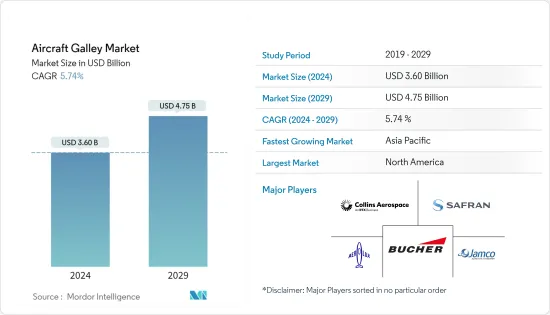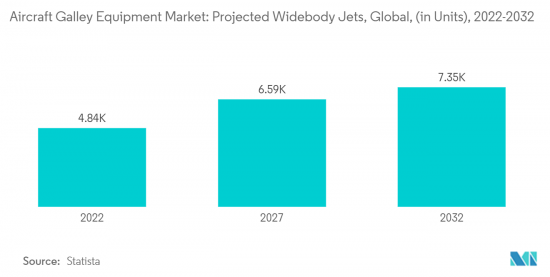PUBLISHER: Mordor Intelligence | PRODUCT CODE: 1404565

PUBLISHER: Mordor Intelligence | PRODUCT CODE: 1404565
Aircraft Galley - Market Share Analysis, Industry Trends & Statistics, Growth Forecasts 2024 - 2029

The Aircraft Galley Market size is estimated at USD 3.60 billion in 2024, and is expected to reach USD 4.75 billion by 2029, growing at a CAGR of 5.74% during the forecast period (2024-2029).
An aircraft galley is crucial for facilitating the services offered to the passengers by the cabin crew. Aircraft galleys significantly enhance the airline's flight experience in terms of the plethora of meal options served to the onboard passengers during a flight. The need to keep up with passenger needs, provision of inflight services, and efficient use of space on aircraft is a driving factor for the adoption of galleys. The demand for onboard services such as meals and beverages has led to the installation of galleys as air transport became a major mode of transport. Airlines recognized that offering these onboard services would be economically beneficial, contributing to passenger satisfaction and potentially bringing additional revenues.
The low-cost carrier (LCC) model focuses on increasing the number of onboard passengers while providing limited services as pay-per-demand. The increasing global market penetration of LCCs has resulted in design challenges to adjust to space constraints inside an aircraft, forcing the galley designers to reduce the size and weight of the galley equipment. Technological and design complexity are certain challenges for the manufacturers of the aircraft galley market. The integration of cutting-edge technology in aircraft galleys, such as the adoption of smart galley solutions that use data analytics and automation to optimize catering operations. In particular, such technologies may help airlines manage their inventories effectively, reduce food waste, and enhance the passenger experience.
Aircraft Galley Market Trends
Twin-Aisle Aircraft to Register the Highest CAGR in the Forecast Period
This heightened air passenger traffic prompted numerous airlines to expand their fleet sizes and modernize their existing aircraft. With the increased global air passenger traffic, the demand for long-haul flights increased. Twin-aisle aircraft are designed to cover these extended routes efficiently, offering higher passenger capacity and comfort. Twin-aisle aircraft are also preferred for premium cabins, such as business and first class, due to their spacious layouts, allowing airlines to provide top-notch services and amenities. Galleys installed onboard these aircraft are utilized to cater to the passengers' wide range of food and drink preferences. Hence, the inserts of a modern galley include several luxurious types of equipment, such as espresso machines and wine chiller inserts. Since airlines perceive differentiated service as a means to enhance their market presence and brand image, the procurement of new-generation aircraft would drive the integration of aircraft galleys, thereby driving the business prospects of the aircraft galley market. For instance, in 2022, Boeing received 213 orders for widebodies. In June 2023, Air India ordered 70 widebody planes, comprising 34 A350-1000s and six A350-900s from Airbus, 20 B787 Dreamliners, and 10 B777Xs from Boeing. These scheduled orders are anticipated to bolster the growth of aircraft galley in twin-aisle aircraft.

Asia-Pacific is Expected to Generate the Highest Demand During the Forecast Period
The robust economic growth, favorable population, and demographic profiles of the populace in developing countries in the Asia-Pacific region are driving the air passenger traffic in the region. The region has seen a significant increase in air passenger traffic during the past decade, mostly due to the tourist destinations in the region and the ease of access to air travel, which is expected to continue during the forecast period. According to Boeing Commercial Market Outlook, China is expected to account for 20% of the total commercial aircraft deliveries by 2040. As per Airbus, the region will require more than 17,600 new aircraft by 2040, given the average 5.3% YoY passenger growth in the region. By 2027, China is forecasted to become the world's largest aviation market in terms of air traffic, and India is forecasted to develop into the world's third-largest aviation market, while other countries, such as Indonesia and Thailand, are forecasted to enter the top 10 global markets. Such favorable trends are anticipated to drive the demand for aircraft galleys in the region. These projections have encouraged aircraft OEMs to primarily focus on enhancing their footprint in the region. For instance, Embraer has planned to increase its aircraft deliveries to 100 per year due to an increase in orders from China and India. The company laid out the groundwork to deliver planes to China, as in November 2022, Embraer's E2 series, the E190-E2 commercial jets, received design certification approval from the Chinese Authorities.
Aircraft Galley Industry Overview
The aircraft galley market is semi-consolidated due to the presence of a limited number of dominant vendors operating at a global level. The market is highly competitive, with players competing to gain the largest market share. Constraints associated with the design and weight of aircraft galley and cancellation of aircraft orders due to macroeconomic factors impede the growth of the market. Vendors must provide advanced systems to aircraft OEMs to survive in an intensely competitive market environment. The dominant market players include Aerolux Ltd, JAMCO Corporation, Collins Aerospace (RTX Corporation), Safran, and Bucher Leichtbau AG. These players mainly compete based on their in-house manufacturing capabilities, global footprint network, product offerings, R&D investments, and strong client base. For instance, In August 2021, Safran launched the MaxFlex galley for the Boeing 737 family. MaxFlex galley provides maximum flexibility, infinite combinations, and easy maintenance. More than 2,000 MaxFlex galleys are installed in the aircraft. Safran also offers SpaceFlex V2 Galley for Airbus A320/A321 aircraft. This galley maximizes an aircraft's floor space and opens an area for additional seats. The competitive environment is likely to intensify further due to an increase in product/service extensions and technological innovations. For instance, in June 2023, Collins Aerospace (RTX Corporation) launched a diagnostic tool for problems in aircraft galleys. The diagnostic tool provides the data required to identify unit faults, which will lead to reduced time in troubleshooting and reduced the occurrence of misdiagnosing unit malfunctions.
Additional Benefits:
- The market estimate (ME) sheet in Excel format
- 3 months of analyst support
TABLE OF CONTENTS
1 INTRODUCTION
- 1.1 Study Assumptions
- 1.2 Scope of the Study
2 RESEARCH METHODOLOGY
3 EXECUTIVE SUMMARY
4 MARKET DYNAMICS
- 4.1 Market Overview
- 4.2 Market Drivers
- 4.3 Market Restraints
- 4.4 Industry Attractiveness - Porter's Five Forces Analysis
- 4.4.1 Bargaining Power of Buyers/Consumers
- 4.4.2 Bargaining Power of Suppliers
- 4.4.3 Threat of New Entrants
- 4.4.4 Threat of Substitute Products
- 4.4.5 Intensity of Competitive Rivalry
5 MARKET SEGMENTATION
- 5.1 Aircraft Type
- 5.1.1 Single-aisle
- 5.1.2 Twin-aisle
- 5.1.3 Business Jets
- 5.2 Geography
- 5.2.1 North America
- 5.2.1.1 United States
- 5.2.1.2 Canada
- 5.2.2 Europe
- 5.2.2.1 Germany
- 5.2.2.2 United Kingdom
- 5.2.2.3 France
- 5.2.2.4 Spain
- 5.2.2.5 Rest of Europe
- 5.2.3 Asia-Pacific
- 5.2.3.1 China
- 5.2.3.2 India
- 5.2.3.3 Japan
- 5.2.3.4 South Korea
- 5.2.3.5 Rest of Asia-Pacific
- 5.2.4 Latin America
- 5.2.4.1 Mexico
- 5.2.4.2 Brazil
- 5.2.4.3 Rest of Latin America
- 5.2.5 Middle East and Africa
- 5.2.5.1 United Arab Emirates
- 5.2.5.2 Saudi Arabia
- 5.2.5.3 Egypt
- 5.2.5.4 South Africa
- 5.2.5.5 Rest of Middle East and Africa
- 5.2.1 North America
6 COMPETITIVE LANDSCAPE
- 6.1 Vendor Market Share
- 6.2 Company Profiles
- 6.2.1 Aerolux Ltd.
- 6.2.2 AVIC Cabin Systems Limited
- 6.2.3 Collins Aerospace (RTX Corporation)
- 6.2.4 Safran
- 6.2.5 Bucher Leichtbau AG
- 6.2.6 Diehl Stiftung & Co. KG
- 6.2.7 Dynamo Aviation Inc.
- 6.2.8 JAMCO Corporation
- 6.2.9 Korita Aviation (Direct Aviation)
- 6.2.10 Miller Fabrication & Welding, Inc.
- 6.2.11 Turkish Airlines Technic Inc.
7 MARKET OPPORTUNITIES AND FUTURE TRENDS




